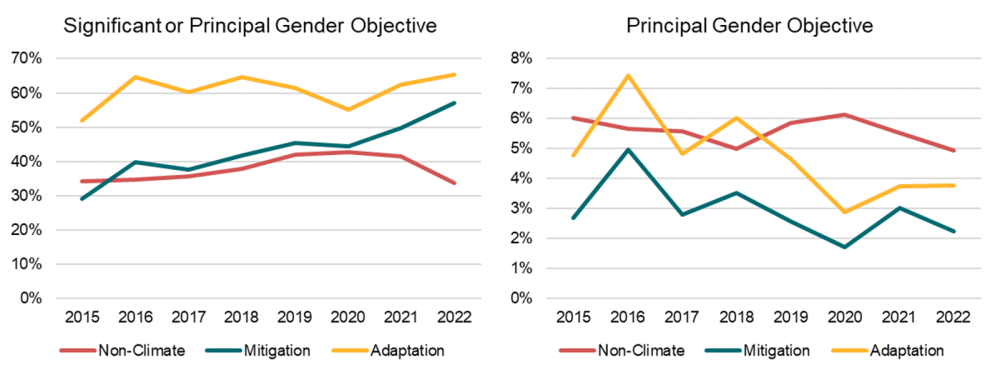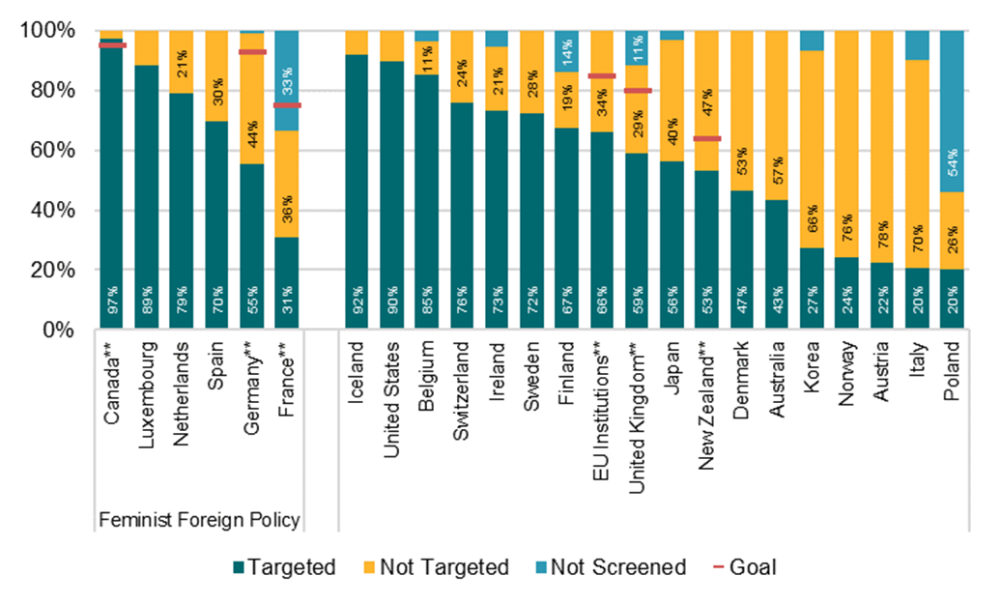Recommended
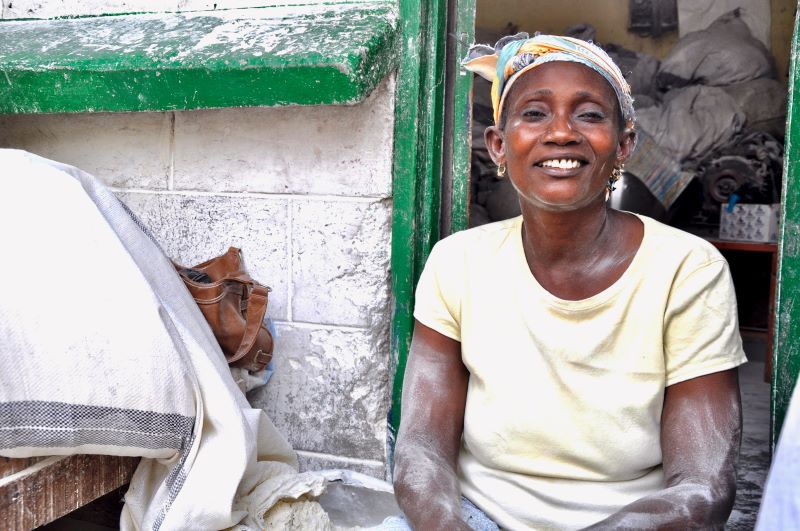
Blog Post
The impacts of the climate crisis do not affect all genders equally. There is mounting evidence, both that climate change can exacerbate or introduce new gender-based vulnerabilities; and that climate interventions targeting gender can not only be more inclusive, but also more effective.
In this blog, we explore how OECD Development Assistance Committee (DAC) providers have been incorporating gender-based targets in their climate-related Official Development Assistance (ODA). We find that development finance categorised as climate-related has increasingly incorporated gender-related objectives since 2015. Both adaptation- and mitigation-marked finance is well-ahead of wider development finance when it comes to accounting for gender. But the percentage of climate-related finance which targets gender as a principal objective has fallen, and gender-targeting remains particularly low in mitigation-relevant areas such as the energy sector. And surprisingly, a number of providers—including some of those with who have adopted “feminist foreign policies” in recent years—still do not screen all of their projects for gender impacts.
Women are both beneficiaries and “benefit multipliers” in climate projects
Women are often disproportionately affected by the impacts of climate change. Women and children are up to 14 times more likely to die than men during climate-related natural disasters, while the aftermath of extreme weather events has also been found to lead to spikes in gender-based violence. When climate change pushes communities into poverty or food insecurity, women often bear additional impacts—in the case of recent climate-related droughts in Kenya, for instance, women and girls forced to walk longer distances to collect water were placed at an increased risk of sexual abuse. When climate change pushes families into economic hardship, girls are also more likely to be pulled out of school or pushed into early marriages.
But incorporating a gender lens in climate projects is not only about equity, it is also about effectiveness. Evidence shows that climate investments can be more cost-effective with a gender lens, with women serving as potential “benefit multipliers” by contributing to the long-term sustainability of climate responses and by maximizing the co-benefits of climate projects within their communities. On the flip side, climate interventions which do not address the “underlying drivers” of vulnerability to climate change—including gender—may inadvertently reinforce or redistribute existing vulnerabilities, leading to climate interventions with inadvertent negative effects.
Gender objectives included in climate projects, but rarely the main goal
Since 2015, when the Paris Agreement was signed, providers have increasingly recognised gender as an objective for climate-marked development projects. The share of climate adaptation ODA marked as having gender equality as either a significant or principal objective rose from 52 to 65 percent between 2015 and 2022 (though this has flatlined since 2016), while mitigation-relevant ODA saw an even sharper equivalent increase from 29 to 57 percent. Indeed, it appears as though climate-marked ODA is now more likely to also target gender equality than non-climate-related ODA.
However, when we look specifically at the share of climate-marked ODA targeting gender as a “principal” objective, this has fallen since 2015, and lags behind the percentage of non-climate ODA—and this is the case especially for mitigation-marked finance. In 2022, just 2 percent of mitigation ODA had a principal gender objective, compared to 4 percent of adaptation ODA and 5 percent of non-climate ODA. This finding also raises important questions about the extent to which mitigation finance—which, by nature, targets global emissions reductions, and is primarily spent in middle- rather than low-income countries—can or should also target local development benefits, including by meaningfully prioritising particularly vulnerable local populations, such as women.
We should note that there is evidence of inflation in gender-markers (and especially within the “significant” gender marker)—and, for that matter, climate markers. If recent data suffers more from this, it would mean at least some of the observed progress is artificial. Ultimately, the markers are a “blunt instrument” for tracking providers’ commitment to complex development issues. Ideally, the consideration of gender within climate projects would go far beyond this, with providers applying a gender-sensitive and gender-responsive lens throughout each project’s design, implementation, reporting, and monitoring. Unfortunately, as the IPCC notes, there remain “very few examples” of successful and holistic integration of gender within climate policies for providers to draw on.
Figure 1: Gender Targeting of DAC Sector-Allocable* ODA: Climate (Adaptation & Mitigation) vs Non-Climate Benchmark
Source: OECD CRS, based on disbursements
*Note: According to OECD guidance, both gender and climate Rio markers should only be applied to sector-allocable ODA, which includes CRS purpose codes 11110 to 43082.
Energy at risk of becoming a “gender-neglected” sector
Looking at the largest climate-relevant sectors shows that energy is particularly at risk of becoming a “gender-neglected” sector—less than 1 percent of climate-relevant energy projects prioritize gender as a "principal" objective, and just 22 percent address gender at all. This finding is in line with prior observations from the OECD, which noted that gender equality is poorly addressed in economic infrastructure sectors. Indeed, the disproportionate impact of energy poverty on women—particularly within their “reproductive” or “caregiving” roles in areas like access to clean cooking fuels—has long been recognised at the household level. While this focus may naturally lend itself to smaller-scale clean energy interventions, applying a gender lens to wider electrification projects could hold value for enabling women to more equally participate in the wider green economy, with studies from Nicaragua and South Africa, for instance, showing that rural electrification can significantly increase women’s employment. Ultimately, however, in line with the wider lack of high-quality evidence on what works within climate finance, evidence on how to make energy finance work better for women—accounting for what we already know about their different energy needs, priorities, and willingness or ability to pay—is still “relatively thin”, further preventing providers from being able to programme their energy finance more effectively.
Figure 2: Share of 2022 Climate-marked ODA targeting gender as a principal or significant objective, by sector
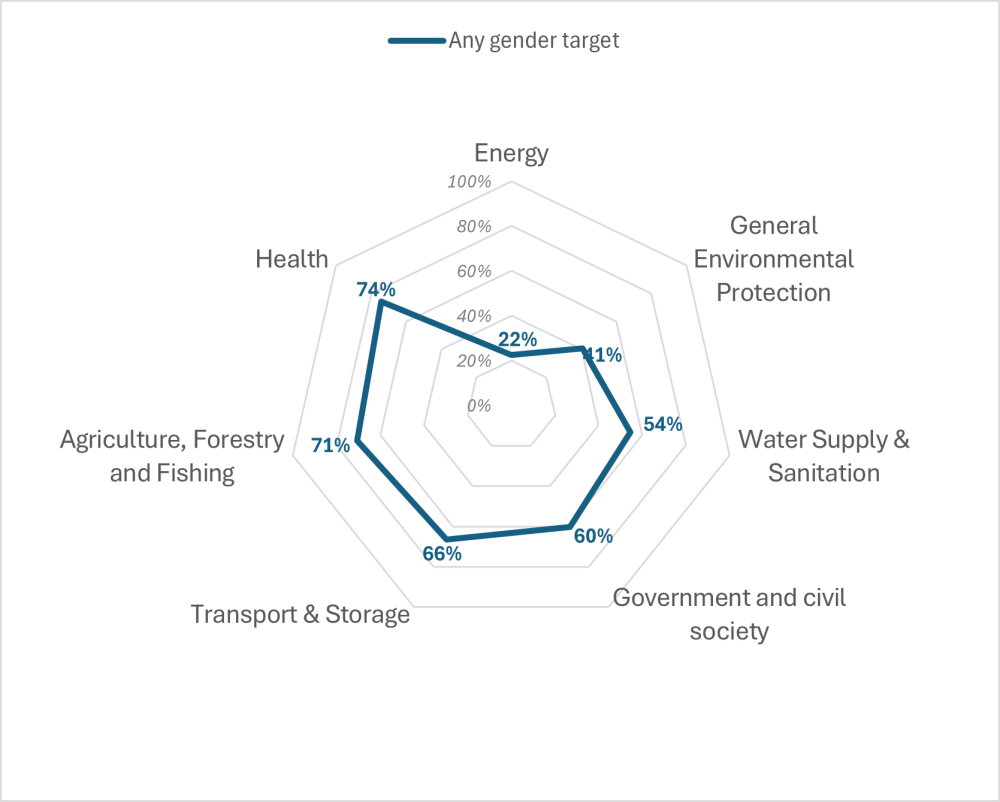
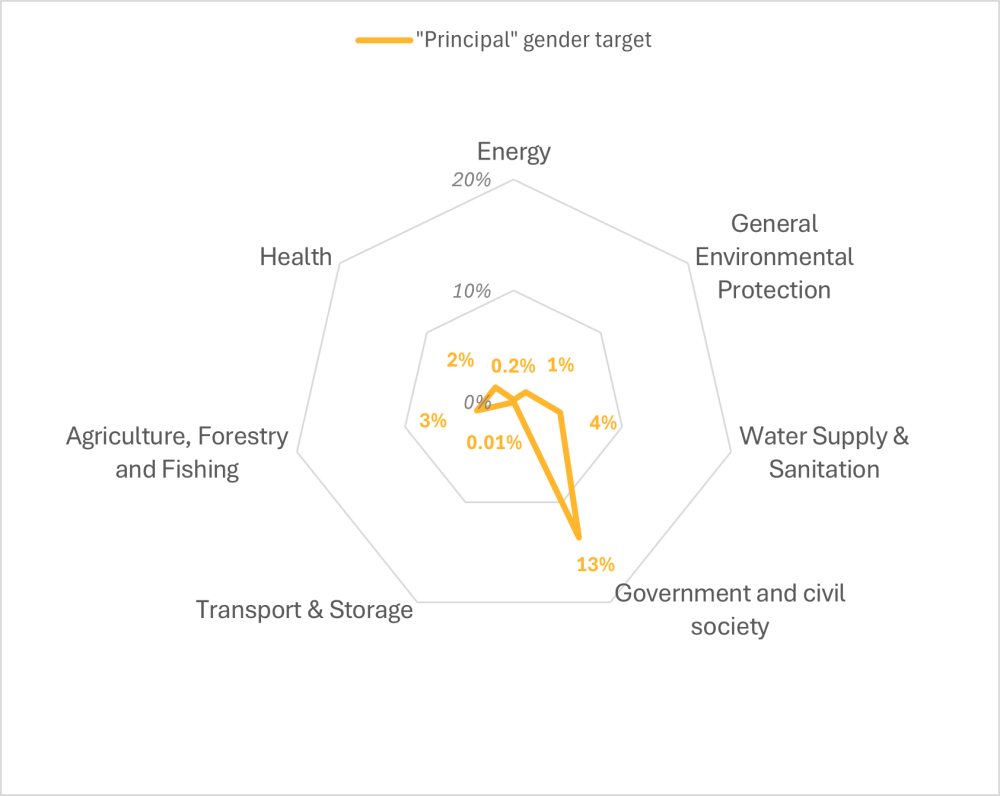
Source: 2022 OECD CRS, based on Rio-marked disbursements by DAC members
Note: These seven sectors accounted for two-thirds of all bilateral climate-marked ODA from DAC providers in 2022
Which providers are aligning climate action with a “feminist” foreign policy?
Canada, Luxembourg, Germany, France, the Netherlands, and Spain are among the countries embracing the concept of a “feminist” foreign and development policy, while others—including the US, UK, EU and Norway have published strategic guidance or gender action plans within their wider concessional climate or development finance. As part of these efforts, some providers have included specific goals for the proportion of finance targeting gender within wider ODA portfolio (Figure 3), though none to date have applied such quantitative targets specifically to climate-relevant finance.
Figure 3: 2022 Climate-marked ODA Gross Disbursements by Gender Marker across DAC Members*
Source: 2022 OECD CRS
*Note: DAC providers with disbursements of climate-marked ODA under $5 million have been excluded (i.e. Hungary, Estonia, Slovakia, Slovenia, Lithuania, and Portugal).
**Note: Goals for share of ODA targeting gender equality include: 95 percent for Canada; 85 percent for the EU; 75 percent for France ; 93 percent for Germany; 80 percent for the United Kingdom; 64 percent for New Zealand. While Sweden used to have a feminist foreign policy, this was abandoned under its new government in 2022.
But practice does not always follow on from policy. Less than a third of French climate-marked ODA targeted gender equality in 2022, despite its ambitious target of 75 percent. France is also a notable outlier amongst DAC providers (alongside Poland, Finland, and the UK) in terms of its high proportion of climate-marked ODA which remains unscreened for gender, potentially exacerbating the wider existing gender data gap. And though the UK aims to “increase the proportion of our International Climate Finance (ICF) that will be gender marked”, this is currently decreasing, as highlighted by the Independent Commission for Aid Impact last week. According to them, the share of UK ICF (i.e. its climate-marked ODA) which does not target or screen for gender rose to over 60 percent in 2023-24.
More screening, evidence, and nuance needed at the intersection of gender and climate
There has been clear progress in taking gender into consideration within climate-related development spending since 2015, with a higher proportion of climate marked-ODA incorporating gender objectives than non-climate ODA. This finding is perhaps surprising, given our previous research which indicated that climate-marked ODA often trails behind other ODA flows in many indicators related to its transparency, evaluation, and effectiveness.
But there’s plenty of room for improvement. Specifically, there has been a decline in the integration of gender as a "principal" objective across all types of ODA—including adaptation and mitigation-related ODA—since 2015, and mitigation finance targeting gender as a "principal" objective remains notably low. For ODA providers wishing to further integrate gender into their climate action, looking at the energy sector presents a particularly promising avenue, given the low share of energy-related ODA currently integrating gender. Providers should also invest further in researching and evaluating current energy projects for their gendered impacts to generate more robust evidence on how energy finance can work better for women. Finally, at the very minimum, all DAC members should actively screen every climate project for gendered impacts, so as to at least consider and gather data on one of the key underlying drivers of vulnerability to climate change.
Disclaimer
CGD blog posts reflect the views of the authors, drawing on prior research and experience in their areas of expertise. CGD is a nonpartisan, independent organization and does not take institutional positions.
Image credit for social media/web: gajendra / Adobe Stock


